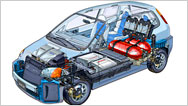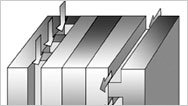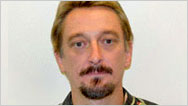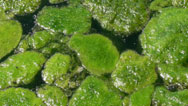Fuel Cells
- Posted 07.26.05
- NOVA scienceNOW
(This video is no longer available for streaming.) Hydrogen fuel cell cars, whose only tailpipe emission is water, are often hailed as one solution to our energy woes. But many hurdles remain, including lowering the cells' cost, building filling stations, and finding green ways to produce hydrogen. Meantime, our NOVA scienceNOW host test-drives a prototype fuel cell car, with "Car Talk" hosts Tom and Ray Magliozzi along for an amusing ride.
Transcript
FUEL CELLS
PBS Airdate: July 26, 2005
ROBERT KRULWICH: Hi, I'm Robert Krulwich, and welcome to NOVA ScienceNOW, where we consider not one, but several science stories. Tonight, they're basically puzzles beginning with a problem, so just...
Come on back. Come on back and...all right, stop. Good. The internal combustion engine, which fouls the air and uses gas which comes from oil—which is getting expensive, involves the Middle East, gets us into all kinds of fights—who wouldn't want to replace this with a more efficient and affordable alternative?
But is there an alternative?
Well, there is this engine we keep hearing about which is supposed to be fabulous. It's coming "soon." But the puzzle is, how soon?
Every year, Detroit unveils, with much to do, a "Car of the Future." And the hoopla here isn't about what this car does. It's about what this car doesn't do. This car doesn't use gasoline, none, because it is powered by a fuel cell.
GEORGE W. BUSH (President of the United States, 2001- ): Fuel cells...
NEWS ANCHOR : ...fuel cells.
NEWS CORRESPONDENT: ...powered by a fuel cell.
GEORGE W. BUSH: Fuel cells are the wave of the future.
NEWS CORRESPONDENT:The wave of the future.
ROBERT KRULWICH: Really? This is the future? Well maybe we should take a closer look.
So I decided to test drive a fuel-cell car, and I invited a couple of friends to come along.
What do we think?
TOM MAGLIOZZI: We don't know anything.
ROBERT KRULWICH: Tom and Ray Magliozzi, the Car Talk guys from National Public Radio.
RAY MAGLIOZZI: What was that whistling noise?
ROBERT KRULWICH: Yeah, what is that whistling?
RAY MAGLIOZZI: What's that about?
ROBERT KRULWICH: Mmmmmm.
TOM MAGLIOZZI: That sounds like F above middle C. I would like to open the hood just to see what's there. Don't shut it off.
RAY MAGLIOZZI: And don't lock the keys in it. I'll leave a window open. I'm dying to see what's under here.
TOM MAGLIOZZI: What the heck is this? See, I knew it. It's not an engine!
ROBERT KRULWICH: Well, it has a box, and it has lots of things connecting to it.
RAY MAGLIOZZI: Yeah, my intuition tells me this is an electric motor.
TOM MAGLIOZZI: This is basically an electric car.
RAY MAGLIOZZI: You know what it sounds like? It sounds like my Norge refrigerator used to sound.
ROBERT KRULWICH: Tom and Ray know a lot about regular cars, the ones with internal combustion engines.
This, on the other hand, is an electric car. But you don't plug it in, instead, it's powered by this mysterious fuel cell thing.
RAY MAGLIOZZI: This is stuff, this is technology that none of us understands.
TOM MAGLIOZZI: No one told us this.
RAY MAGLIOZZI: Do we need help? We need help.
ROBERT KRULWICH: Maybe we should ask...
RAY MAGLIOZZI: We need someone, a passerby, just some ordinary citizen.
ROBERT KRULWICH: Dan.
TOM MAGLIOZZI: Who?
ROBERT KRULWICH: Oh, my god. Thank goodness the car comes with its own expert, Dan Kelly, who works for a company that actually makes fuel cells.
RAY MAGLIOZZI: So it has an electric motor. What runs the motor?
DAN KELLY: All the electricity comes from the fuel cell. And the fuel cell is really made up of a collection of these.
ROBERT KRULWICH: This is a fuel cell? It looks like a black plastic license plate.
DAN KELLY: This is one cell. And it's like a sandwich; you just stack them up. You want more power, add more cells. Make a bigger sandwich. And what goes through, if you look at it...
RAY MAGLIOZZI: It's a piece of plastic!
DAN KELLY: ...and the grooves that are in it...
ROBERT KRULWICH: Yeah, what is this?
DAN KELLY: ...you get...Hydrogen runs through these grooves.
ROBERT KRULWICH: So what's really going on inside these little holes? How is this thing making electricity?
Well, inside the fuel cell, there are two sets of tiny passageways separated by a membrane. And if you look very close, the two main sections are kind of like the two sides of a tennis court. On one side is hydrogen and on the other side oxygen, and then there's the membrane that separates them. It's kind of like a net.
So here we are in a tennis court. I, of course, you'll notice now, represent the atom oxygen, and for those of you who are oxygen atoms yourselves, you'll, of course, recognize that I have eight electrons. This is a fuel cell, so oxygen is opposite hydrogen. There are two hydrogen atoms, and if you'll rotate please, you'll see that they too each have one electron. Now it is in the nature of this kind of chemistry that hydrogen and oxygen are attracted to each other.
RAY MAGLIOZZI: I yearn for you, Robert.
ROBERT KRULWICH: You yearn for me, but there is a membrane between us. Now the rules of the fuel cell are you will try to come to me—try to come to me—but you'll have to go under or through the membrane. Try under the membrane.
TOM MAGLIOZZI: Try under. Okay.
ROBERT KRULWICH: Down they go, the two hydrogen atoms approaching the oxygen with ardor, but notice now...
TOM MAGLIOZZI: We can do it! Robert, I love you!
ROBERT KRULWICH: ...through the membrane...
TOM MAGLIOZZI: We made it, Robert! We made it! Oh, my god, finally.
ROBERT KRULWICH: Now, but—and I use the word "but" advisedly—could you please rotate? So show the audience your butts at this moment. You'll notice that this has got no electron; no electron here. The question has to be asked, "Where are the electrons?"
Remember when the hydrogen had to come through the membrane? Well, when it did that, its electrons were stripped off. Electrons simply aren't allowed through the membrane in a fuel cell.
But they do want to come to the other side. So very cleverly, they go around the membrane, right at the edge of the fuel cell, over and over and over again. And moving electrons, well, that's electrical current. That's what lights up a light bulb, or, in this case, what powers your car.
And here's what makes the fuel cells so clean: after the electrons get to the other side, they rejoin their old friends, hook up with the oxygen, and before you know it, you've got H2O—water—pretty neat.
So in these cars, when you check the tailpipe, instead of exhaust, what you get...
RAY MAGLIOZZI: ...is water.
ROBERT KRULWICH: Oh, how do you know?
RAY MAGLIOZZI: 'Cause it looks like water.
TOM MAGLIOZZI: Take a drink. Lick it. Lick it!
He's dead! I didn't like him anyway.
ROBERT KRULWICH: The very idea that a car's motor could be this clean has an enormous appeal, especially to certain politicians. They act like it's going to be easy—well, sometimes they do—but as it turns out, there's a catch, actually, a bunch of catches. Fuel cells are still very expensive to make, they wear out more quickly. And, oh, yeah, there's another thing...
DANIEL NOCERA (Massachusetts Institute of Technology): A fuel cell needs fuel, so we've been talking about hydrogen and oxygen as our fuel. There's lots of oxygen. But where are we going to get the hydrogen in the first place?
ROBERT KRULWICH: MIT chemistry professor, Dan Nocera, says, "Remember, you've got to have pure hydrogen, all by itself, on one side of the membrane to get things going."
So where do you get pure hydrogen? Well, there's plenty of hydrogen on earth; it's just not pure. It's stuck to other stuff, like oxygen, in water, of course. And hydrogen can be found in fuels like natural gas, you know, hydrocarbons.
But if you take it out of there—and that's where most hydrogen comes from today—you do get a waste product, carbon dioxide. And that's one of the bad guys in global warming.
So what's the answer?
DANIEL NOCERA: I think water is the key for the future.
ROBERT KRULWICH: Every high school chemistry student knows how to split water into hydrogen and oxygen. You just run electricity through it. That's electrolysis.
But hydrogen and oxygen are so cozy and comfortable together, you use up so much electricity prying them apart, it could cost a fortune. So we are facing a significant technical problem here: how do we find a cheap, clean source of hydrogen?
Oh, and there is another issue...
RAY MAGLIOZZI: Excuse us for a minute.
TOM MAGLIOZZI: We'll be right back.
ROBERT KRULWICH: Yeah. Don't we worry a little bit about the danger problem?
RAY MAGLIOZZI: What about the Hindenburg?
ROBERT KRULWICH: Yeah, what about the Hinden...the huge balloon the Germans...
RAY MAGLIOZZI: Yeah. Oh, the humanity...the whole thing.
TOM MAGLIOZZI: We've got to ask him.
RAY MAGLIOZZI: Yeah, Come on.
TOM MAGLIOZZI: Dan...
RAY MAGLIOZZI: What about the Hindenburg? Remember the Hindenburg?
TOM MAGLIOZZI: Yeah, what about the Hindenburg? Yeah.
DAN KELLY: The Hindenburg?
ROBERT KRULWICH: The Hindenburg pretty much ruined hydrogen's reputation. But after the explosion, the fire here, the continuous flames that you see, some say they came from the canvas blimp which was coated with highly flammable shellac.
DAN KELLY: Are you comfortable getting back in now?
RAY MAGLIOZZI: Not really, no. I'll be walking back.
ROBERT KRULWICH: One moment, one moment.
Of course, gasoline is flammable, too, and we drive around with gallons of that in our cars.
It's something else about hydrogen...
NATHAN LEWIS (California Institute of Technology): Well, hydrogen's a gas.
ROBERT KRULWICH: Okay, so?
NATHAN LEWIS: That means most of the space between the hydrogen molecules is not useful to make energy. There's nothing there.
ROBERT KRULWICH: So says Nate Lewis, a scientist at Caltech.
Getting enough hydrogen into a car is a challenge, because it likes to spread out, and you've got to squeeze a lot of it into a small place.
You can't use an ordinary gas tank to hold it, because it would burst open. And you wouldn't want that.
Did I run a stop sign?
RAY MAGLIOZZI: Noooooooo.
ROBERT KRULWICH: No? All right.
So the hydrogen tanks have to be super strong, to hold hydrogen squeezed in at pressures up to five to ten thousand pounds per square inch. But even with that special tank, it's tough to get enough hydrogen in the car. For instance, to drive 300 miles, you might need a gas tank four times the size of the one you've got now.
Which leads Professor Lewis to suggest the best place for hydrogen fuel might be in power stations, to light up cities and factories.
After all, why rush to put this fuel out on the road, when you can easily store plenty of it in a factory basement?
So you're a put-it-in-the-basement guy?
NATHAN LEWIS: Put it in the basement first. And then, if we ever figure out how to use it to move us around, that will be great. But your car is the last place that you want to put hydrogen.
ROBERT KRULWICH: But the dream of a car that spews out nothing but water is so appealing. And if we could use water to fuel the car, that would be even better.
TOM MAGLIOZZI: When the technology is really there, you'll be able to open up that little gas fill and fill it up with water like my brother used to do when he was a kid.
DAN KELLY: Yeah. So the car will run...
ROBERT KRULWICH: But the technology to get hydrogen from water efficiently and affordably? That technology doesn't exist yet.
Well, is there anything that we know of that does this regularly, that breaks apart water and...?
DANIEL NOCERA: We do. It's the leaf.
ROBERT KRULWICH: The, the what?
DANIEL NOCERA: Leaf.
ROBERT KRULWICH: The leaf. It turns out the leaf is a pro at splitting water. In photosynthesis, leaves take water and break it down. The oxygen goes into the air—thank goodness, because that's what we breathe—and the hydrogen hooks up with carbon to make carbohydrates, which the plant needs for fuel. And the energy to do all this comes from the sun.
So does Dan Nocera want to "make like a leaf?"
DANIEL NOCERA: So what we've been doing is trying to actually, not duplicate what a leaf does, but we're saying, "Can we generate hydrogen and oxygen by entirely new ways?"
ROBERT KRULWICH: In his lab, lasers stand in for the sun.
DANIEL NOCERA: What we do is we bring this laser beam in, and now you see, actually, here's a compound that's capturing that green light.
ROBERT KRULWICH: So this is your version of sunshine, and this is your version of something that sunshine is acting on?
The laser shoots through a liquid mixture concocted in Nocera's lab. He's trying to design a chemical, something like this pink peapod thing, that does a special trick, so when light hits it, it will pull apart the H from the O.
Have you ever taken a droplet of water and found a way to just release hydrogen?
DANIEL NOCERA: We haven't done water, but we've done hydrochloric acid and we've been able to make hydrogen.
ROBERT KRULWICH: So that's a "no." But there are labs all over the country now working on hydrogen. Some work with algae, some with solar collectors. And these guys are making hydrogen from water and sunlight.
But at least for now, it's very expensive. And just last year, the National Academy of Engineering and the National Research Council reported there are "major hurdles" on the path to a hydrogen economy, and that clearing them "will not be simple."
So even though the President is saying we could have hydrogen cars for today's generation...
GEORGE W. BUSH: The first car driven by a child born today could be powered by hydrogen and pollution-free.
ROBERT KRULWICH: If the car's really going to be pollution-free, the hydrogen in the tank will have to come from a clean source, and so far, when it comes to splitting water, we're way behind the leaf.
Dan and other scientists are trying to catch up and will keep trying, but the secret, he thinks, may be very subtle.
So how long did it take for the leaf to figure out how to separate hydrogen from oxygen?
DANIEL NOCERA: That took between two and four billion years.
ROBERT KRULWICH: But how much time do you have?
DANIEL NOCERA: I'm guessing around 20 more years.
ROBERT KRULWICH: And so, whatever the politicians may say, learning to "make like a leaf" could take a while.
Okay, so we do have time then for a very short puzzle? This one lasts fifty seconds, exactly, unless, of course, you happened to guess the answer earlier.
MAN: The key ingredient of this substance was originally extracted from the sapodilla tree. Nowadays, the formulation is coated with fine particles of sucrose and enclosed by a thin layer of aluminum seven microns thick. It contains synthetic materials blended with natural products, such as leche caspi and masuranduba. On contact with the enzyme amylase, secreted by glands in the buckle cavity, its texture is transformed to a malleable compound with elastic properties. After several minutes grinding in a heterodont interface, oral fatigue often leads to removal of the sticky molecular structure and adhesion to a suitable surface.
ROBERT KRULWICH: Well, if you got that one, we do have another one at the end of program. It involves a filter-feeding sedentary metazoan. We think you'll probably want to stick around for that.
Credits
Fuel Cells
- Edited by
- Doug Quade & Dick Bartlett
- Written, Produced and Directed by
- Julia Cort
NOVA scienceNOW
- Executive Producer
- Samuel Fine
- Executive Editor
- Robert Krulwich
- Senior Series Producer
- Vincent Liota
- Supervising Producer
- Andrea Cross
- Development Producer
- Kyla Dunn
- Associate Producer
- Win Rosenfeld
- Program Editor
- David Small
- Unit Manager
- Candace White
- Senior Researcher
- Jason Spingarn-Koff
- Production Secretary
- Hong Jung
- Music
- Rob Morsberger
- NOVA scienceNOW Series Animation
- Edgeworx
- Associate Producers
- Marty Johnson
Anthony Manupelli
Mary Robertson - Compositing
- Yunsik Noh
- Camera
- Edgar Boyles
Joel Coblenz
Brian Dowley
Anthony Forma
Mark Gunning - Sound Recordists
- Ted Gesing
Mike Karas
David Pickner
Erik Reisner
Merce Williams - Aerial Production Coordinator
- Billy Richards
- Audio Mix
- John Jenkins
- Animation
- Mitch Butler
Sputnik - Production Assistant
- Robbie Gemmel
- Interns
- Maxwell Foxman
Jonathan Lung - Special Thanks
- Robin Abbott
Waleed Abdalati
California Fuel Cell Partnership
Ted Driscoll
Maria Ghirardi
The Metropolitan Museum of Art
National Renewable Energy Laboratory
Polytechnic University
Simon Stephenson
United Technologies Company
Brian Von Herzen - Howard Hughes Medical Institute Investigator
- Gregory Hannon, Cold Spring Harbor Laboratory
- Archival Material
- ABCNEWS VideoSource
Avalanche, Inc.
BBC Motion Gallery
Corbis Corporation
Getty Images
Photoresearchers - NOVA Series Graphics
- yU + co.
- NOVA Theme Music
- Walter Werzowa
John Luker
Musikvergnuegen, Inc. - Additional NOVA Theme Music
- Ray Loring
- Post Production Online Editor
- Spencer Gentry
- Closed Captioning
- The Caption Center
- NOVA Administrator
- Dara Bourne
- Publicity
- Adina Barnett
Lisa Cerqueira
Jonathan Renes
Diane Buxton
Olivia Wong - Senior Researcher
- Barbara Moran
- Production Coordinator
- Linda Callahan
- Unit Manager
- Lola Norman-Salako
- Paralegal
- Richard Parr
- Legal Counsel
- Susan Rosen Shishko
- Post Production Assistant
- Alex Kreuter
- Associate Producers, Post Production
- Nathan Gunner
Patrick Carey - Post Production Supervisor
- Regina O'Toole
- Post Production Editor
- Rebecca Nieto
- Post Production Manager
- Maureen Barden Lynch
- Supervising Producer
- Stephen Sweigart
- Producer, Special Projects
- Susanne Simpson
- Coordinating Producer
- Laurie Cahalane
- Senior Science Editor
- Evan Hadingham
- Senior Series Producer
- Melanie Wallace
- Managing Director
- Alan Ritsko
- Senior Executive Producer
- Paula S. Apsell
NOVA scienceNOW is a trademark of the WGBH Educational Foundation
This material is based upon work supported by the National Science Foundation under Grant No. 0229297. Any opinions, findings, and conclusions or recommendations expressed in this material are those of the author(s) and do not necessarily reflect the views of the National Science Foundation.
© 2005 WGBH Educational Foundation
All rights reserved
- Image credit: (fuel cell car) © ANDREW WONG/Reuters/Corbis
Participants
- Robert Krulwich
- Host, Radiolab
- Nate Lewis
- California Institute of Technology
- Dan Nocera
- Massachusetts Institute of Technology
Related Links
-

Clickable Fuel Cell Car
Take a look inside a prototype hydrogen fuel cell car and see what makes it go.
-

How Fuel Cells Work
You need some hydrogen, some oxygen, a special membrane, a couple of catalysts, and presto—you've got power.
-

Fuel Cells: Expert Q&A
Eric Miller of the Hawaii Natural Energy Institute answers questions about hydrogen fuel cells, their promise, and more.
-

Algae Fuel
In the search for alternatives to gasoline, are algae the answer?
-

Fuel Cells
In this video, hydrogen fuel cell cars promise pollution-free driving, but will we see them anytime soon?



